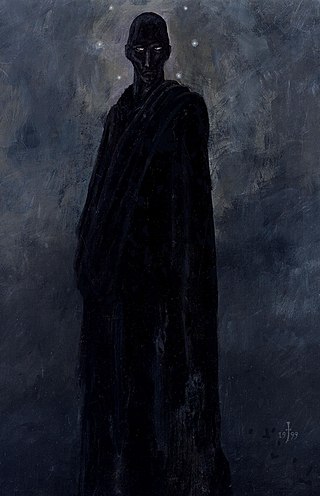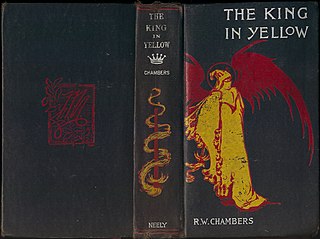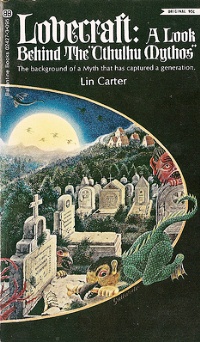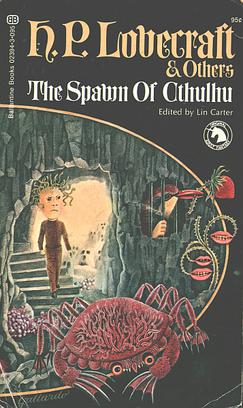Related Research Articles

The Cthulhu Mythos is a mythopoeia and a shared fictional universe, originating in the works of American horror writer H. P. Lovecraft. The term was coined by August Derleth, a contemporary correspondent and protégé of Lovecraft, to identify the settings, tropes, and lore that were employed by Lovecraft and his literary successors. The name "Cthulhu" derives from the central creature in Lovecraft's seminal short story "The Call of Cthulhu", first published in the pulp magazine Weird Tales in 1928.

Cthulhu is a fictional cosmic entity created by writer H. P. Lovecraft. It was first introduced in his short story "The Call of Cthulhu", published by the American pulp magazine Weird Tales in 1928. Considered a Great Old One within the pantheon of Lovecraftian cosmic entities, this creature has since been featured in numerous popular culture references. Lovecraft depicts it as a gigantic entity worshipped by cultists, in the shape of a green octopus, dragon, and a caricature of human form. The Lovecraft-inspired universe, the Cthulhu Mythos, where it exists with its fellow entities, is named after it.

Nyarlathotep is a fictional character created by H. P. Lovecraft. The character is a malign deity in the Cthulhu Mythos, a shared universe. First appearing in Lovecraft's 1920 prose poem "Nyarlathotep", he was later mentioned in other works by Lovecraft and by other writers. Later writers describe him as one of the Outer Gods, an alien pantheon.

Mi-Go are a fictional race of extraterrestrials created by H. P. Lovecraft and used by others in the Cthulhu Mythos setting. The word Mi-Go comes from "Migou", a Tibetan word for yeti. The aliens are fungus-based lifeforms which are extremely varied due to their prodigious surgical, biological, chemical, and mechanical skill. The variants witnessed by the protagonist of "The Whisperer in Darkness" resemble winged human-sized crabs.

The King in Yellow is a book of short stories by the American writer Robert W. Chambers, first published by F. Tennyson Neely in 1895. The book is named for the fictional play with the same title which recurs as a motif through some of the stories. The first half of the book features highly esteemed horror stories, and the book has been described by critics such as E. F. Bleiler and T. E. D. Klein as a classic in the field of the supernatural. Lin Carter called it "an absolute masterpiece, probably the single greatest book of weird fantasy written in this country between the death of Poe and the rise of Lovecraft".

Azathoth is a deity in the Cthulhu Mythos and Dream Cycle stories of writer H. P. Lovecraft and other authors. He is the ruler of the Outer Gods, and may be seen as a symbol for primordial chaos.

Hastur is an entity of the Cthulhu Mythos.
Carcosa is a fictional city in Ambrose Bierce's short story "An Inhabitant of Carcosa" (1886). The ancient and mysterious city is barely described and is viewed only in hindsight by a character who once lived there.

Lovecraftian horror, sometimes used interchangeably with "cosmic horror", is a subgenre of horror fiction and weird fiction that emphasizes the horror of the unknowable and incomprehensible more than gore or other elements of shock. It is named after American author H. P. Lovecraft (1890–1937). His work emphasizes themes of cosmic dread, forbidden and dangerous knowledge, madness, non-human influences on humanity, religion and superstition, fate and inevitability, and the risks associated with scientific discoveries, which are now associated with Lovecraftian horror as a subgenre. The cosmic themes of Lovecraftian horror can also be found in other media, notably horror films, horror games, and comics.

The Whisperer in Darkness is a 26,000-word novella by American writer H. P. Lovecraft. Written February–September 1930, it was first published in Weird Tales, August 1931. Similar to The Colour Out of Space (1927), it is a blend of horror and science fiction. Although it makes numerous references to the Cthulhu Mythos, the story is not a central part of the mythos, but reflects a shift in Lovecraft's writing at this time towards science fiction. The story also introduces the Mi-Go, an extraterrestrial race of fungoid creatures.

Lovecraft: A Look Behind the "Cthulhu Mythos" is a 1972 non-fiction book written by Lin Carter, published by Ballantine Books. The introduction notes that the book "does not purport to be a biography of H. P. Lovecraft", and instead presents it as "a history of the growth of the so-called Cthulhu Mythos."
A Cthulhu Mythos anthology is a type of short story collection that contains stories written in, or related to, the Cthulhu Mythos genre of horror fiction launched by H. P. Lovecraft. Such anthologies have helped to define and popularize the genre.

The Spawn of Cthulhu is an anthology of fantasy short stories, edited by American writer Lin Carter. It was first published in paperback by Ballantine Books in October 1971 as the thirty-sixth volume of its Ballantine Adult Fantasy series. It was the fifth anthology assembled by Carter for the series.
Necronomicon is the second album by Neoclassical darkwave/dark ambient musical duo Nox Arcana published by Monolith Graphics on October 10, 2004. The music is inspired by the stories of horror writer H. P. Lovecraft and is a tribute to the Cthulhu Mythos.
"The Book" is an unfinished short story by American horror fiction writer H. P. Lovecraft, believed to have been written in late 1933. It was first published in the journal Leaves in 1938, after Lovecraft's death.
American author H. P. Lovecraft (1890–1937) created a number of fictional deities throughout the course of his literary career. These entities are usually depicted as immensely powerful and utterly indifferent to humans who can barely begin to comprehend them, though some entities are worshipped by humans. These deities include the "Great Old Ones" and extraterrestrials, such as the "Elder Things", with sporadic references to other miscellaneous deities. The "Elder Gods" are a later creation of other prolific writers who expanded on Lovecraft's concepts, such as August Derleth, who was credited with formalizing the Cthulhu Mythos. Most of these deities were Lovecraft's original creations, but he also adapted words or concepts from earlier writers such as Ambrose Bierce, and later writers in turn used Lovecraft's concepts and expanded his fictional universe.
This is a list of fictional creatures from the Cthulhu mythos of American writer H. P. Lovecraft and his collaborators.
References
"I, Cthulhu" not only directly references H. P. Lovecraft's writings, but also incorporates other creations of the shared fictional universe surrounding Lovecraft's work, the Cthulhu Mythos. A full list of the various references are below:
- Azathoth: One of "the boys", a deity created by H. P. Lovecraft and first seen in The Dream-Quest of Unknown Kadath .
- Carcosa: An ancient mysterious, and fictional city from the Ambrose Bierce short story "An Inhabitant of Carcosa", later incorporated into the work of Robert W. Chambers and H. P. Lovecraft. Cthulhu's first waypoint on his way to Earth.
- Dagon: Encountered by Cthulhu on Earth, his ally in world domination, another deity created by Lovecraft and first mentioned in the short story "Dagon".
- De Vermis Mysteriis : A fictional grimoire created by Robert Bloch and supposedly written by "alchemist, necromancer, [and] reputed mage", Ludwig Prinn. First mentioned in the short story "The Shambler from the Stars", and referenced in Lovecraft's own writings.
- Hastur: A cosmic entity/god created by Ambrose Bierce and first mentioned in his short story "Haïta the Shepherd". The name was later used both by Chamber and Lovecraft in their writings, and then by Gaiman himself in his novel Good Omens , co-authored by Terry Pratchett. Cthulhu's uncle, according to the narrative.
- The King in Yellow: A mysterious and malevolent supernatural entity from Robert W. Chambers' book of short stories The King in Yellow. In "I, Cthulhu", he is a friend and ally of Cthulhu, pointing him towards Earth as a worthwhile place to conquer and rule.
- Nyarlathotep: One of "the boys", a deity created by H. P. Lovecraft and first seen in the short story "Nyarlathotep".
- Shub-Niggurath: One of "the boys" (despite being gendered female in many Cthulhu Mythos writings), a deity created by H. P. Lovecraft and first mentioned in the short story "The Last Test" (1928).
- Tsathoggua: One of "the boys", a supernatural entity created by Clark Ashton Smith, found in the short story "The Tale of Satampra Zeiros".
- Yog-Sothoth: One of "the boys", a deity created by H. P. Lovecraft and first encountered in The Case of Charles Dexter Ward .
- Yuggoth: One of "the boys". Yuggoth is, according to Lovecraft's work, a planet, but Gaiman has instead favored the interpretation that Yuggoth is, in fact, a sentient being.
- Shoggoth: A creature that Cthulhu constantly reminds Whateley that must be fed.